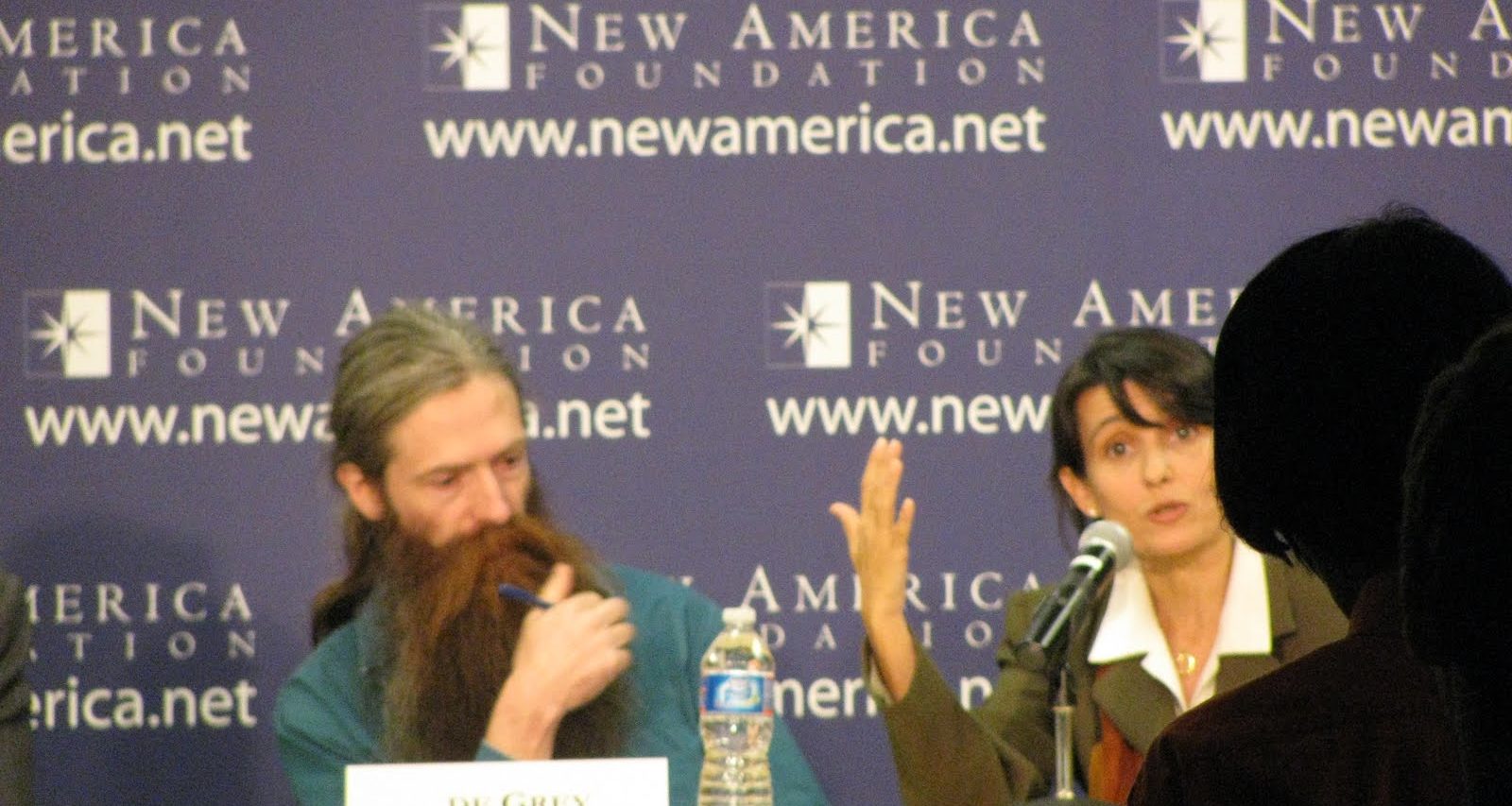
The first panel today is on the science of life extension, with a typically crisis-laden title, “The War on Dying, the Battle Against Aging.” (And a heated exchange ensues toward the end of the panel — don’t flip that dial.) The first two speakers, Cynthia Kenyon of UCSF (revealingly profiled here) and Ana Maria Cuervo of the Albert Einstein College of Medicine, are researchers. They share some familiar anecdotes about the biology of aging: tapeworms whose lifespans were extended several times over by flipping a couple genes, and so forth.
Aubrey de Grey and Ana Maria Cuervo.
One interesting experimental result I hadn’t heard before is that if you attach an old, infirm mouse to a young, healthy mouse and then inflict a bruise on the healthy mouse (it must be something to sit around thinking up the idea to do this sort of thing), the old mouse will heal much faster than if the young mouse didn’t have the wound. The panelist describing this says that this shows that “external interventions can have a great effect on the body.” This seems like a strange way of putting it, since the “external” intervention is in fact the internal workings of another organism’s body.
Stephen Johnston of Arizona State’s Biodesign Institute seems at first to be the voice of reason in this setting: he talks about approaching aging from the standpoint of disease and detecting and treating early chronic diseases. He offers have a practical, clinical perspective on life extension, noting his initial trepidation about the title of the conference, because “I’ve known a lot of radicals that I’m not sure I’d want to extend their life.” (Um, don’t look to your left, Mr. Johnston, where Aubrey de Grey sits.)
But soon enough Johnston starts heading into transhumanist territory, saying we’ll be melding with robots and computers and increasingly turning ourselves into them. After all, he says, we already have mechanical implants, and “computers already have the computing capacity of our brains.” Ooof. I imagine quite a few people here will believe that because he’s speaking with an air of scientific authority, but let me just note that this claim is well outside his field. Indeed, let me go further, and knock it down outright: we don’t know how to define the whole function of the brain as a computer, and so we can’t define the brain’s “computing capacity” generally. All we can do is compare its performance on particular computational tasks, like adding. This is why computers can perform many sorts of tasks billions of times faster than us, but there are many other tasks we can do that they can’t even perform at all, because we don’t know how to define them computationally. Apples and oranges, folks, certainly for the time being.
Next up, and given the largest speaking slot, is Aubrey de Grey, the aging researcher and activist. He says that radical life extension is a turn-off to a lot of people, “especially people on Capitol Hill,” because they imagine it as people getting old and extending the frail and infirmed portion of their life indefinitely. This is a pretty old understanding of radical life extension (Jonathan Swift depicts it this way in Gulliver’s Travels), though I think he’s also alluding to the problems life extension would potentially pose (and has already posed) for our social and health care systems. De Grey is right, of course, to push back against the idea that life extension would have to occur that way. But it doesn’t seem at all apparent that it necessarily wouldn’t; he’s just saying that it won’t because life-extensionists are trying to prevent that outcome. But the current explosion of chronic and degenerative diseases as life spans increase isn’t hugely supportive of his assertion. Radical life extension, as de Grey well knows, will have to take a form very different from just continuing the life extension we’ve seen so far.
At the end of the panel, Cynthia Kenyon throws some cold water on the anecdotes from the beginning about tapeworms, noting that the same interventions have not produced nearly as dramatic results in mice, and seem to be even less powerful in more complex organisms such as humans — though Kenyon seems also to be setting up how little we know and have tried as reason for optimism about what new interventions we could find. Aubrey de Grey agrees that “the combinatorial approach [flipping genes] rapidly approaches diminishing returns.”
From left to right, Cynthia Kenyon, Stephen Johnston, a questioner (obscuring Ana Maria Cuervo), and moderator Emily Yoffe.
And now for the juicy, tabloid coverage of the conference you’ve all been waiting for: Near the end of the Q&A session, a little spat broke out between Stephen Johnston and Cynthia Kenyon over NIH funding and whether research projects need to have a specific, practical, and easily politically justifiable aim, or whether open and “pure” research should remain funded. Kenyon placed herself on the moral high ground of defending pure research, comparing Johnston to the infamous head of the U.S. Patent Office in the nineteenth century who supposedly declared that everything that could be invented had been (actually an apocryphal story). But it wasn’t clear to me that Johnston was making the point Kenyon imputed to him. I’ll have to watch the video again later, but it was a weird, rude little spat.
(Dear Prudence: I’m moderating a national conference and two of my panelists keep yelling at each other and accusing each other of philistinism. Do I let them duke it out over a live feed? Signed, Moderately Befuddled. [Actually, moderator Emily Yoffe, Slate‘s “Dear Prudence” columnist, wisely and adroitly headed off the exchange and moved on to the next question.])
Fireworks aside, it’s been pointed out to me that the most entertaining part of this panel is watching Aubrey de Grey play with his beard — and watching the other panelists watch him.

Futurisms
November 16, 2010

